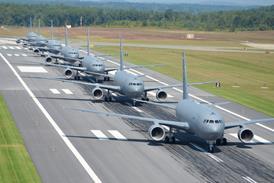Stewart Penney / Washington dc
Lockheed Martin claims to have solved problems with in-flight refuelling pod
Lockheed Martin has passed a series of milestones in developing the tactical capabilities of the C-130J Hercules, including air dropping of paratroops and cargo pallets as well as concluding operational evaluation of the aircraft as an aerial tanker for the US Marine Corps.
The company also expects a major boost to the aircraft's operational capabilities shortly with approval of the latest software standard, Block 5.3, by the Royal Australian Air Force and US Air Force. Block 5.3 software introduces full operational capability, including automatic station-keeping and other improvements.
The USAF concluded air-drop testing at Edwards AFB, California late last month using three long-fuselage C-130J-30s. Completed tests include parachute-assisted deployment of pallets weighing up to 19,000kg (42,000lb) and paratroop drops from 25,000ft (7,600m). At the end of this month, the aircraft will deploy to Pope AFB, North Carolina, for trials with the US Army's 82nd Airborne, which will include paratroops drops. Following this month's trials the aircraft will be delivered to the Rhode Island Air National Guard in early November.
Lockheed Martin says it has also fixed problems with the Flight Refuelling in-flight refuelling pod on the US Marine Corp's KC-130J, essentially by returning to the design used on the first generation Hercules.
It finished testing of the revised pod late last month using the KC-130J as a refueller for helicopters and the Boeing F/A-18 Hornet. The USMC has ordered 52 KC-130Js and expects a further 70 to be ordered for the USMC Reserve.
Source: Flight International























